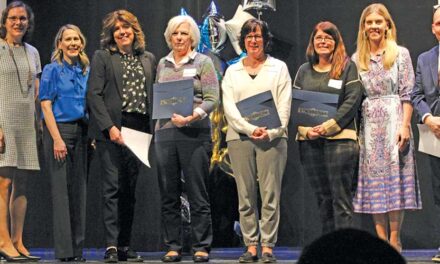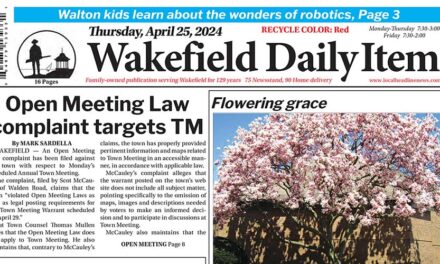By MARK SARDELLA
WAKEFIELD — The area of the watershed believed to be contributing to the loading of phosphorus into Lake Quannapowitt has been downsized based on updated information that suggests that much of the area west and northwest of the Lake actually runs off to Walkers Brook in Reading.
Town Engineer Michael Collins told the Lake Quannapowitt Water Quality Study Committee last night that based on information from environmental engineering firm Wright-Pierce, the watershed area believed to be contributing to the algae causing nutrient level has been reduced from 747 acres down to about 460 acres. Collins said that this means that the amount of phosphorus draining into the Lake from the surrounding land areas is about 325 kilograms per year as opposed to the previously estimated 414 kg per year.
While there might be less phosphorus, Collins stressed that the new information also means less water to handle the nutrient.
Phosphorus is believed to be the major factor causing the severe blue-green algae blooms in recent years which tend to turn the Lake water a deep green color by late summer.
Drainage from the watershed area is just one of the sources of the nutrient that the Lake Committee has been studying. Collins also called the committee’s attention to a study that committee member Bill Butler found concerning goose droppings. According to that study, each Canada goose can contribute a half pound of phosphorus per year.
In an e-mail to the committee Butler notes that he has been counting the geese around the Lake since before 2007, when the town contracted with a goose control service. Since then, he reports the average number of geese around the Lake has been about 40. Forty geese would contribute 20 lbs. (or 9 kg) of phosphorus per year to the Lake, Butler estimates, adding that prior to goose control the total number of geese was about 120.
Collins also conveyed to the committee information on alum as a potential treatment for excess phosphorus in the Lake. Alum binds to phosphorus in the water and forms a “blanket” that rests on the Lake bottom. He reported on the experience with alum treatment at Devil’s Lake in Oregon. Observers at that 650 acre lake observed that wave action from wind and storms tended to churn up the alum blanket on the lake bottom. The benefit was found to be short term, Collins said, with the algae blooms returning after a couple of years.
Collins said the alum treatment is expensive, estimating that it would cost as much as $3 million to treat a lake the size of Quannapowitt. Based on the cost and apparent limited effectiveness, Collins said that he was rethinking the possibility of alum as a solution to the local problem.
He said that at Devil’s Lake a decision was made to go with a diffuser system to aerate the water from the bottom up.
Collins also reported that under the mandatory federal National Pollutant Discharge Elimination System (NPDES) requirements, a consulting firm will be testing storm drain outfalls around the Lake for phosphorus and other contaminants. (The NPDES permit program controls water pollution by regulating point sources that discharge pollutants into waters of the United States.) Committee members wondered if the committee would have access to the consultants’ findings. Member Doug Heath asked if the committee should put its own work on hold pending the findings of the consultants.
But Collins argued that the committee should continue its work, if only to increase its knowledge and be in a better position to evaluate incoming data from any testing.
Member Bill Boodry asked Collins if it would make sense for the consultants retained by the town to come and talk to the committees. Collins agreed that it would make sense.
On another subject, Heath wondered if an effort could be made to determine the specific type of algae in the Lake and its health impact. Heath noted that he has been sampling the Lake every month for five years but his equipment cannot determine the exact type and toxicity of the algae. Blue-green algae take a variety of forms, ranging from relatively harmless to quite toxic.
Heath agreed to contact some area universities to see if any graduate students might be willing to take on such a study this summer.
Committee member Dennis Cloherty said that he would like to make a presentation at the committee’s next meeting regarding his belief that cleaning out and re-establishing flow into the Lake from conduits like Walkers Brook would provide enough flow to clean out the Lake at very low cost.
Members again expressed skepticism that restoring that flow would be sufficient to solve the existing problems but agreed to hear Cloherty’s presentation at their April 13 meeting.




